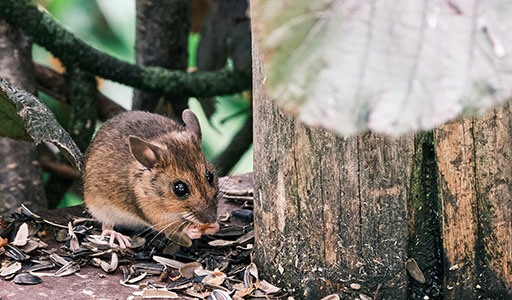Mice

Mouse Information
Mouse is a common name that generally but imprecisely refers to rodents found throughout the world with bodies less than 5 inches long. Scientifically speaking, mouse refers to any of the 38 species in the genus Mus, which is the Latin word for mouse.
There are eight main species of mouse that lives in the US: the house mouse, deer mouse, white-footed mouse, harvest mouse, cactus mouse, cotton mouse, woodland jumping mouse, and California mouse.
Infamous for their frequent invasion of houses and stratospheric breeding rate, mice have dispersed well beyond their native lands of Asia, largely as a result of human settlement. They are nocturnal animals, and their eyesight is abysmal. They compensate for this with their acute hearing, which still isn’t enough to keep them from being relentlessly preyed upon by a large number of animals, including reptiles, mammals, and birds (especially owls). In the wild, mice—primarily ground dwellers—build intricate burrows, the designs of which have been shown to be a genetic trait.
Along with rats, mice are one of the world’s most prevalent and destructive pests. They can nest in your home and hide in areas not frequented by humans. The characteristics that make them so successful as a species—namely their high breeding rate and very adaptive diet—also make them a formidable nuisance. Because a mouse’s incisors never stop growing, they must constantly file down by gnawing on things such as the foundations of homes.

What does a mouse look like?
Mice have a slender body, a blunt or tapered muzzle, scantily haired, large ears, and a near-hairless tail that is oftentimes as long as the body itself. They have narrow hind feet with sharp claws and bald soles. There is a broad variation in fur color and texture among mouse species, but perhaps the most common color configuration is gray to brown upperparts, white underparts, and white feet. The smallest mouse species is the aptly named pygmy mouse, a resident of sub-Saharan Africa, which weighs 3 to 12 grams, and has a body a mere 2.3-3.1 inches long. On the other side of the spectrum, one of the largest mice is the flat-haired mouse, which is native to India. Weighing in at around 18 grams, its body is still far smaller than that of a rat, at only 4 to 4.7 inches (not including the tail). This is to be expected, though, as the principal difference between rats and mice is sheer size.

What does a mouse eat?
All mice are omnivores, but diet does vary somewhat among mouse species. The house mouse, for instance, consumes seeds and insects when outdoors, but indoors, these highly opportunistic feeders will munch on basically anything that’s digestible, including grains, cereals, chocolate, fruits, meat, pet food, and even the contents of trash cans. Most other species eat a combination of plants (especially seeds), insects, and other invertebrates. Mice and rats have also been known to resort to cannibalism, but only in times of abject starvation; for example, it is not unheard of for a mother mouse to eat her young if food is not forthcoming.

Where do mice live?
All mouse species are native to Asia and Africa, where they live in scantily vegetated deserts, steppes, rocky slopes, open grasslands and grassy patches in tropical deciduous forests, fallow fields and croplands at northern latitudes, and rice fields. Some mouse species, such as the house mouse, have extended beyond their natural habitat as a result of human settlement. There are now several mouse species that live in North America, such as the house mouse, deer mouse, wood mouse, harvest mouse, cactus mouse, and cotton mouse. They are primarily ground dwellers, and most species, especially those living in the savannas and grasslands, excavate burrows and chambers in which they build globular nests of dry vegetation. In houses, tend to occupy areas of structures that humans do not frequent, such as the insides of walls and cabinets, suspended ceilings, or even in the voids inside appliances like stoves—or possibly even in the engine bay of your beloved automobile.
How long do mice live?
The average lifespan of a wild mouse is typically one to two years, while pet mice can expect to live a year longer. Getting into the realm of pure anomaly, a couple of pampered laboratory mice have reached the age of four and a half.
When do mice give birth?
Male house mice court females by emitting special ultrasonic calls in the 30-110 kHz range. These calls are made mostly during courtship, when the male mouse sniffs and follows the female around; however, they can continue when mating has begun. Males have been shown to emit these calls when exposed to female pheromones. The calls also appear to be quite complex; they seem to differ between individuals and have therefore garnered comparisons to bird songs. House mice can produce up to 14 litters of 1-12 offspring per year.
Mice have built-in hardware to deter inbreeding. In house mice, the major urinary protein (MUP) gene cluster imbues urine with a scent specific to a certain genetic identity. Other house mice are therefore able to use this information to determine if they are kin or not; there are fewer sexual encounters between mice sharing MUP proteins than would be expected if mating was random. Another mechanism to discourage inbreeding becomes apparent when a female mates with several males. When this happens, an egg-driven sperm selection process kicks in that discourages sperm from related males from fertilizing eggs.
How do I prevent mice from getting into my home?
Mice are fascinating, surprisingly sophisticated little creatures. They are also the quintessential pest. Not only are they disease carriers, but they also constantly gnaw on things to keep their teeth from growing too long, and if a whole colony of them elect to use your house’s foundation for this purpose, structural damage can result. With that said, let’s take a look at a few measures homeowners can take to avoid unpleasant confrontations with mice:
- Seal gaps. Mice can enter your house through extremely narrow gaps, which can easily be plugged by wire wool (which mice cannot chew through), caulk, metal kick plates or cement.
- Declutter. Messy rooms are mouse sanctuaries, as there are countless things for them to hide in or under. Get as many objects as possible off the floor, and if possible, move furniture away from the walls so you can check what’s behind them.
- Eliminate food sources. Rodents are attracted to your house for three reasons: food, water and shelter. Rodent prevention is simply a matter of eliminating all to the greatest extent possible—and food is perhaps their biggest draw. Store all food—especially pet food, which people tend to think nothing of leaving out—in sealed containers, and if you have birdfeeders, consider moving them further away from the house or even taking them down completely until the issue has been dealt with.
- Call an expert. If you think you might have a mouse infestation, it is probably best to get in touch with an expert quickly. A professional wildlife removal service such as Trutech would be the most capable of dispatching such a nuisance, as our team has both the equipment and training to effectively locate and ensure the prompt removal of mice.
Frequently Asked Questions
Common pests found around homes, mice and rats are both potentially dangerous to people and their property. Certain differences can help homeowners tell these two rodents apart:
- A mouse is typically 5 to 7 inches long and weighs around half an ounce.
- A rat is larger, up to 18 inches in length including the tail, and can weigh up to one pound.
At times, it is possible to confuse a juvenile rat with a mouse. However, young rats have much larger heads and feet than the typical house mouse.
Droppings are one of the first ways to discover an infestation in the home. However, rat and mouse feces can be similar in appearance, so it is important to be able to differentiate one from another. Mouse poop is typically:
- About one-fourth of an inch in length
- Tapered at either one or both ends
- Dark brown or black in color, based on diet
Because mice defecate while moving, mouse droppings do not usually collect in piles. Instead, the pests excrete about 50 to 75 pellets daily along their favorite routes between nests and food sources.


